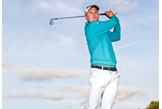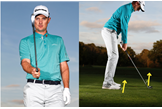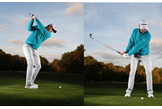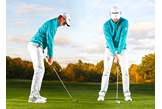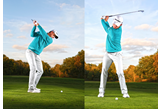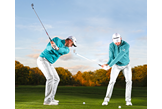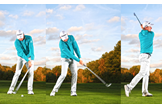Justin Rose: 7 Ways to hit it pure
Last updated:
Justin Rose: 7 Ways to hit it pure
Known as one of the Tour’s ‘flushers’, Justin Rose has been an elite ball-striker for more than a decade.
Working with coaches Sean Foley and Justin Buckthorp to improve his swing technique and physical conditioning, he has been able to keep up with the new generation of power hitters that play the game in a different way to Rose, who came up through the ranks in the 1990s – before the days of high-launch, low-spin drivers.
Here, Rose and Foley will show you how to improve your ball-striking so you can hit the ball longer, straighter and more consistently.
STEP 1: GET FOCUSED ON ALIGNMENT
Where the clubface is aiming at impact heavily determines where the ball will launch so my process is always to aim the clubface at a very specific target and then build my address position around the club.
JUSTIN SAYS
You’ve probably seen me go through this routine a few times over the years. What I’m doing here is using the clubshaft to create a line between the ball and my intended target. Once I’ve got the shaft, ball and flag perfectly in line, I pick out a small target – a patch of grass or a divot – a few feet in front of my ball on that line and aim the clubface squarely to it. Trust me, it’s much easier to square yourself to a target a few feet away than one 160 yards in the distance.
FOLEY SAYS
Justin has had this pre-shot alignment routine for years. What I like almost as much as the fact that it helps him accurately aim the clubface is that it looks so bad-ass. He reminds me of King Arthur in Excalibur! To me, though, this is more than just an alignment aid – it’s a definition of intent, especially in the heat of battle during the final stages of a tournament.

The top players are obsessive about alignment. You should be too.
Justin Rose: “When you’re out on Tour hitting thousands of shots each week, it’s easy for your basics to get out of ‘sync’ over a period of time – often without you even realising. Alignment is a crucial part of the pre-shot routine but it’s actually the easiest thing to get right. It only takes a few seconds to double- check where you’re aiming but it can save you a handful of shots each round.”
Sean Foley: “When you point at anything, it means something, and that’s the real lesson here. Aiming the clubface to your target is a vital component of the golf swing so if Justin is particular about it enough to go through this routine on every single shot, you should take it seriously, too.”
STEP 2: BUILD A STABLE BUT DYNAMIC ADDRESS POSITION
At address I’m looking to do two key things. First, I want to create a solid base for my swing. I’m going to be swinging the club at more than 100mph, so I’m going to need stability – lots of it! At the same time, I’m also looking to prime my body for the actual process of creating all that power and energy. I like to have a light ex in my knees and a straight lower back with ever so slightly rounded shoulders.
JUSTIN SAYS
I like to feel ‘heavy’ through my feet, like I’m gripping the ground with my toes at address. This helps me to stay centred over the ball and to keep my head still asI turn, rather than swaying o the ball in the backswing. For irons, my weight just favours my front foot. I spread my weight 50/50 with the driver to help me hit up on it more.
FOLEY SAYS
The set-up is often overlooked as a swing ‘position’ but it’s vitally important given that it goes from being un-dynamic to being ready to swing a golf club at 110mph in just a matter of seconds. Your feet are a crucial component in that process. If your foundation is o , the whole structure pays a price.
Use your feet to store and release power: Focus on the relationship between your feet and the ground
Sean Foley: “During our practice sessions in the Bahamas, I’ll often have Justin hit balls out of a fairway bunker with a 6-iron in his bare feet. It is just a beautiful thing to watch. He’ll usually slip a couple of times initially, then his body adjusts, his intuition takes over and he starts to become subconsciously aware of how his feet are working. I’m not recommending you do the same, but better awareness of your foot action will improve your rhythm and your ball-striking.”
Justin Rose: “It’s very important to understand the connection between your body and the ground during the swing. It’s not just a support, it’s a source of leverage that you can use to store and release energy.”

STEP 3: GIVE YOUR BACKSWING TIME TO DEVELOP
I’ve found it’s better to take the club away a little outside the line so when you get to the top, the momentum helps shift the club to the inside as you move into your transition. This will improve your swing path coming into impact. Taking the club away too far on the inside is a big reason why many amateurs come over the top and hit across the ball with a slice motion. I like to think of my backswing as a spring. I’ve got all day to create the tension. It will uncoil with power, irrespective of how quickly I create that tension in the backswing.
JUSTIN SAYS
One of the key things I focus on in my takeaway is to remain centred over the ball. I like to feel that my chest remains pointing down at the ground as I turn my upper body. This helps me prevent any sliding or swaying motion to the side during the backswing.
I like to feel the clubhead moves first in the takeaway since it travels the furthest distance in the swing. Giving the club a slight ‘head start’ helps ensure all components of my swing arrive back at impact together.
FOLEY SAYS
Some players like to set the club early and then turn, while others prefer to move the club away in a one-piece motion. Justin likes to feel that the clubhead moves first because it has the longest distance to travel in the swing. What I will say is that, in reality, he generates that ‘set’ through the entire backswing. That matches his philosophy of building the power in stages.
STEP 4: MATCH ANGLES AT THE TOP
Once I’ve set the club halfway back, my left arm stays pinned to the chest and my big muscles ‘ferry’ the club to the top of my backswing. I like my left arm, my shoulder pitch, my left wrist and my clubface to all match one another at the top. From here, I feel I can just rotate through the ball. If my left arm gets too high, I need to wait for it to drop down into the delivery area. If it gets too at, it always tends to move too far outside the line coming into the ball.
JUSTIN SAYS
In recent years, Sean and I have worked hard on getting my left arm in the correct position at the top. We’ve experimented with having the arm a little higher but we always come back to our blueprint where my left arm plane matches the plane of my shoulders.
It is very important to give yourself enough time to complete your backswing before you start the downswing. You want to ‘settle’ at the top before starting down, otherwise you’ll come over the top.
FOLEY SAYS
Although we’ve shortened Justin’s backswing a touch, we don’t want to overdo it. One thing all great long-iron players have in common is they maintain the length of their backswing. You never see a great ball-striker with a long, laid o swing (shaft aiming left). You also never see a great ball-striker who is short and across the line at the top.

STEP 5: UNWIND FROM THE GROUND UP TO CONTROL YOUR TRANSITION
The transition is the difference between a good player and a great player. I work hard on my downswing sequencing because it needs to be as instinctive as possible. I get everything moving from the ground up to store energy. My hands are the last thing to be delivered through impact.
JUSTIN SAYS
Starting down, my hands drop as my hips start to turn, which keeps the club on plane while adding lag for speed. I focus on the feeling of keeping my backside fixed against an imaginary wall. This stops me standing up and losing my angles.
FOLEY SAYS
The biggest swing focus for Justin with his irons is ensuring his left arm doesn’t get trapped behind him starting down. A good swing thought is to think about keeping the triangle formed between the shaft and arms in front of the chest in his transition.

The transition is the real moment of truth:The downswing is so instinctive there’s no time to influence the strike
Sean Foley: “When you’re into your transition, in real terms you’re actually only about 0.001 of a second from impact. That means you have very little control over how the clubhead is delivered to the ball. In this respect, the transition is the real moment of truth, not impact. If you’re not in good shape here, it’s pretty much impossible to consciously ‘save’ your swing coming into impact. There’s simply not enough time.”
Justin Rose: “Holding the body angles I created at address helps keep the club on plane and leads to iron shots with a descending angle of attack.”
STEP 6: KEEP THE HANDLE OF THE CLUB LOW THROUGH IMPACT
I like to feel that the grip of the club is as low as I can get it at impact. That helps me turn the corner quicker to the left in the follow-through, which slows down clubface rotation so it stays squarer for longer through impact. If you stand up out of posture, the handle gets high and your ball-striking will su er because there will be less compression. The more open my body can look at impact, the better.
FOLEY SAYS
Once Justin has hit a good top-of-the-backswing position, it’s really just a matter of how open he can get his chest and pelvis area at impact in conjunction with keeping the handle of the grip as low as possible. This leads to optimum ball compression at impact.
JUSTIN SAYS
Imagining that the fastest part of my golf swing will occur just beyond the ball encourages me to store the power and energy late into my downswing so I can release it when I really need it. I’m still feeling centred over the ball even though I’m rotating my body hard.
1. I like to feel that my hands lead the club just before impact and that the handle of the club is as low as I can get it.
2. Even as I’m rotating left through the ball, I’m still focusing on turning around that single axis. No lateral movement.
3. Some people like those long, willowy follow-throughs, but I don’t see the point. I like my finish short and punchy.

STEP 7: MAKE A SHORT, PUNCHY FINISH
The finish position matters because it’s directly influenced by everything that’s happened before. When I have a controlled and balanced follow-through and finish like this, I’m never going to hit a bad shot. I call it having ‘good brakes’ because everything is shorter when I have a good follow-through, almost like a punch shot. When I have a bad follow- through, the club feels like it’s been thrown down the line out of control.
JUSTIN SAYS
My follow-through is still something of a work in progress. I haven’t yet totally mastered it. The nature of my swing, where I stay centred and rotate around a single axis naturally means my finish is not as full as that of some other players.
FOLEY SAYS
Justin’s compact finish shows he’s generated speed and transferred that speed. Now he can decelerate at speed, too. Think of Bruce Lee throwing a punch. The power is concentrated, not a long, extended movement Tommy Fleetwood has a similar technique.
READ NEXT
> Jon Rahm: Short Game Masterclass
> Tommy Fleetwood: My 5 tips for lower scores
> Ian Poulter: Match play tips
> Tyrrell Hatton: Driving Power & Accuracy
> Henrik Stenson: Ball Striking Tips
> Thorbjorn Olesen: How to shape your iron shots

